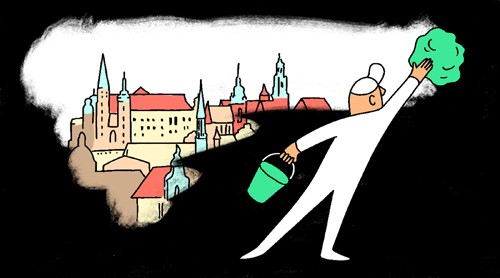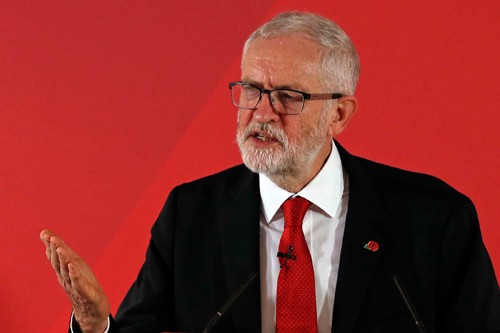Observations / Global
Riding the waves
Cleaning up Krakow, preserving the skills of Portuguese artisans and naming the president of Switzerland: the year ahead is set to be full of challenges. We meet the people who are finding solutions to the problems on their doorstep, from Helsinki to Ho Chi Minh City.

The new Maine attraction
Lobster country turns to kelp
The lobster roll from Reds Eats lobster shack, which overlooks Sheepscot River in Wiscasset, is arguably the best in Maine. Customers queue for hours for a pile of fresh, hot lobster meat atop a hotdog bun. But the changing climate could mean that the crustacean won’t always be so readily available. Maine has seen record harvests in recent years; statewide catches were worth more than $484m in 2018. Lobsters make up three quarters of the state’s fishing income but they don’t like warm water – and 2019 was the hottest year on record.
Entrepreneurs believe that kelp is at hand. The seaweed grows in shallow coastal waters and might yet ensure the financial success of fishing in Maine. Abigail Carroll arrived from Paris in 2012 to launch Nonesuch Oysters in the Scarborough estuary. Its skincare products made from kelp help to balance the books off-season. Lisa Scali and Mitch Lench’s company, Ocean’s Balance, sells seaweed-based condiments such as kelp purée, wakame flakes and bonito sprinkles. “Seaweed was interesting to me from an ecological, sociological and business perspective,” says Lench. “Seaweed is the most nutrient-dense plant on the earth and it captures carbon. Seaweed goes beyond food: it provides solutions.”
Briana Warner (pictured) agrees. Her firm, Atlantic Sea Farms, helps Maine’s fishermen to diversify their income. “We provide seeds, help them get leases, provide training and buy everything they grow,” she says. The firm then turns the seaweed into food products to sell to natural-food stores in the US.
The potential global market for edible seaweed is expected to hit $8.8bn (€7.9bn). Too good to be true? Scientist Nichole Price, from Maine’s Bigelow Laboratory for Ocean Sciences, is optimistic but watchful. “Maine has the capacity to support seaweed aquaculture that is therapeutic to water quality,” she says. “But we need to grow the industry in a sustainable way.”

Foundation class
Architecture school for children
Seven-year-old Oscar is building an overpass with wooden blocks and glue. He places a bucket of playdough on top to test its sturdiness. “It needs to be high enough for boat traffic to pass under it and strong enough to withstand cars and pedestrians,” he says. The bridge holds the weight but fails a more important test: Oscar’s friend Miio smashing it to pieces. The boys burst out laughing.
The Arkki School of Architecture in Helsinki is no ordinary architecture school. Children aged four to nine are learning the basics of building – and having fun while they’re at it. “We give them problems to solve, tasks that are rooted in their own world,” says teacher (and architect) Minna-Mari Paija. “We don’t lecture and we don’t use books.”
In one class the pupils are building miniature deep-sea exploration vessels; in another they are designing transformable houses. The shelves are brimming with their earlier creations: it’s a wonderful glimpse into the boundless imagination of small children. “Why can’t we build houses underwater?” says nine-year old Sofia. “It would be so much more fun to look at fish instead of walls.” She is surrounded by models of everything from hillside housing to imaginary cities, skyscrapers and castles.
Founded in 1993, the school now attracts about 800 pupils a year for its extracurricular courses – and that’s just in Helsinki. Arkki School also has outposts in China, Thailand, Vietnam, the Czech Republic and Greece. With urbanisation around the globe showing no signs of slowing down – and likewise concern about climate change – the role of sustainable architecture is only going to gain importance. Educating the next generation of architects – or, simply, anyone who lives in a city – from a young age is a smart thing to do, particularly as the children here seem to be taking to the task with an enthusiasm unmatched by adults.
More often than not the architectural training that these children receive goes beyond the classroom. Some parents says that they’ve woken up in the middle of the night to find their offspring engaged in urban planning. Not all of them will end up pursuing what they’ve learnt at Arkki as a career but school principal Jaana Räsänen is no less satisfied. “Some of our pupils have become architects but that’s not our goal,” she says. “We want to raise citizens that understand the importance of architecture in creating a good living environment for us all.”

Smog burner
Krakow tackles air pollution
Pawel Scigalski, Krakow’s minister for air quality, is pointing to a map on his computer showing the historic city’s pollution levels; the centre is a reassuring green. But when his finger moves across the screen to Krakow’s outskirts, where the map turns an alarming shade of red, his smile fades. Thanks to coal still being burnt in its suburbs, Poland’s former capital often suffers from thick smog, especially on wintry days.
Krakow’s air is some of the dirtiest in Poland – in fact 33 of the 50 most polluted cities in the EU are here. The reason? Coal is still the main source of domestic fuel in the country and politicians call it Poland’s “black gold”.
Krakow’s recent turnaround is the result of campaigners fighting for it to clean up its act. For the past five years the local government has been phasing out solid-fuel boilers and stoves; a complete ban on burning coal and wood came into effect this September. The tipping point, though, was a petition and protest organised by Polish Smog Alert. The group continues to campaign and runs workshops on the dangers of polluted air. “It’s not like air pollution wasn’t around before Polish Smog Alert started in 2013,” says the group’s Magdalena Kozlowska. “But people didn’t say anything so politicians didn’t need to do anything about it.”
The conversation has also spurred entrepreneurs into action. Start-up Airly provides detailed pollution readings via its smart sensors, a service it sells to local governments. It was founded by friends who were training for a marathon but couldn’t get readings that would help them decide where to run. “The younger generation in Krakow is amazing,” says Airly’s Marcin Gnat. “They have the guts and talent to change things.” There are now more than 200 sensors in the city and some 250,000 people accessed Airly’s online map last year.
Activists and city hall will be keeping a keen eye on smog levels here come winter. Both believe that regulations have to be implemented across the entire country but the links between those in power and the mining industry are still too entrenched. Change is the air though. “What’s happening in Krakow proves that it is possible,” says Gnat.

No place to hide
Cock an ear to lipreading
It’s morning in a London café and the co-working crowd have settled in. I’m trying to guess what people are saying but I can’t make out the words over the din. But Tina Lannin can follow every word. Lannin is deaf but she can lipread from six metres away. It’s key to her ability to understand people and also her primary means of making a living: she is the founder of forensic lipreading firm 121 Captions.
It seems that I’m not the only one who’s curious to know what people out of earshot are talking about: the media’s desire to find out what public figures are up to off-mic has created a high demand for lipreaders. Lannin’s first projects consisted of trying to work out what people were saying in the background of Jihadi ransom videos. “It was harrowing,” she says. “The work bookings are slowly built up; the celebrities and politicians came later.”
Nearly half her work is for newspapers and TV stations seeking to break stories on indiscreet outtakes; a 20-second video can take hours to decode. She was asked to lipread comments made by UK opposition leader Jeremy Corbyn (pictured) in 2018; he was accused of calling Theresa May a “stupid woman” but claimed that he had said “people”. “The shape of the words ‘people’ and ‘woman’ are completely different,” says Lannin.
That’s why Lannin employs seven lipreaders – at least two working on each project to verify results. All of the staff are deaf; Lannin says that it’s a pre-requisite for a good lipreader: “If you’ve been lipreading people all your life you should be good at it.”

Picture postcards
Something to write home about
Dan Ulrichs works with global artists to produce covetable artworks in the form of a €1.50 postcard. “The first print run was 10,000 with six or seven artists; I thought they would last five years,” he says. “In six months we were sold out.”
That was in 2015. Now the business – based in Galway, Ireland – produces 40,000 cards a year. Ulrichs has worked with 40 artists, printing some 700 works as postcards, greetings cards and posters. Last year he launched publishing firm Artwerk 1 Press, which commissions 12 in-house artists to create exclusive pieces. Most recently he started selling his postcards wholesale; 12 retailers in Ireland and abroad have stocked up. For all the fears that postcards might soon become a vestige of the past, Ulrichs’ business sends a hopeful message.
Creating a publishing company in Galway wasn’t easy. Ulrichs was running his family toy shop, the Wooden Heart, when he decided to pursue something that resonated more deeply with him. “I loved design, architecture and art,” he says. He realised that he had to establish the market he wanted to sell to. “I had to create something that would bring people through my doors. That’s where we looked at coffee.”
Coffeewerk + Press became known for the quality of its roast and the deft hands of its baristas. Ulrichs knew that this would draw attention to the other wares in his shop. It’s easy to walk out with more than a cup of coffee. Customers flick through cards divided by artist, from surreal mushroom illustrations by Ross to monochrome collages by Larissa Haily Aguado. The first floor is filled with design objects; Futagami’s brass trivets sit beside earthenware from Arran St East in Dublin. The second floor is a poster gallery.
By the window, two residents are enjoying a coffee. Ulrichs’s international vision is kept alive by the community. “It’s great that young people find us,” he says. “But the 60-year-old couple who come in every Sunday – that’s what warms my heart.”

Mind your business
Mass-scale meditation
My eyes are closed and the room is silent but for the droning of a shruti box: an Indian instrument that’s similar to a harmonium. The 300-strong audience has been asked to repeat a humming sound; my voice wobbles before latching on to the correct pitch. I’m at The Big Quiet, a mass meditation series launched in New York in 2015. Four years later the company embarked upon a US roadtrip, visiting 10 cities. This event, at the 1895 McKim Building at Boston Public Library, is the last stop.
Founder Jesse Israel starts with an icebreaker. Members of the audience are asked for their name, go-to karaoke song and a description of something they’ve done for themselves recently. Then come the breathing exercises, which include raising our hands and pulling them down with a shout and making animal noises. Next up are a series of mindfulness exercises before the 75-minute event is wrapped up with musical performances.
Even though I was expecting a little more quiet time than I ended up getting, there’s no doubt that Israel and his team are on to something. Everyone seems to want a piece of the wellness pie, whether it’s luxury hotel brands or start-ups working on mobile apps – and it’s a trend that looks set to continue in 2020. But the more meditation gains ground, the more it is being sold. Does something so personal remain effective on an industrial scale – and with such high production values?
Israel says that the motivation to found The Big Quiet came from his own experiences of feeling anxious and lonely in a big city, and the realisation that “the thing we crave most is human connection”. But the 35-year-old realises that not everyone engages with the New Age, incense-burning idea of spirituality. Instead his aim has been “to create entry points that make these experiences more accessible”, which is why he sees the nexus of music, entertainment and brand collaborations playing a part in The Big Quiet’s future. He hopes to take the firm’s events overseas and deliver mass meditations to as many as 20,000 people at a time.
While I didn’t quite achieve spiritual enlightenment on this soggy evening in Boston, I realise that the path is a long one. Yet I’m a little disappointed with myself: while we were being asked to concentrate on our heartbeat, I found my mind wandering. Israel says that this is perfectly normal – but I’m reluctant to confess that it landed on what I was having for dinner.

From Shanghai to Saigon
French expats ditch China for Vietnam
Maison Marou, a Parisian-style café-cum-chocolate factory in Ho Chi Minh City, is abuzz with customers. Founders Samuel Maruta and Vincent Mourou (pictured) are in expansion mode: a third outlet is due to open in 2020. The city’s booming F&B industry is attracting fresh talent. “Saigon [as residents still call it] feels like Shanghai did at the start of the decade,” says Maison Marou’s Julie de Bruyne. For many the change has been more noticeable over the past few years. when cars became commonplace and modern homes started to dot the skyline. “Saigon is a magnet for young French,” says Maruta.
Ho Chi Minh City is opening its doors at the same time that Shanghai is shutting up shop. French entrepreneurs are nudged towards the door while aspiring graduates, who are struggling to get visas, are heading to Vietnam instead. “In the government’s eyes, every foreigner working in China is stealing the job of a Chinese,” says De Bruyne, who often bumps into friends from Shanghai in Ho Chi Minh City.
China’s policy shift is heavy-handed but it is also a sign of Shanghai’s progress: regulations are up, corruption is down and outside talent is surplus to requirements. Henri-Charles Claude, country manager of building-management firm Aden Services (one of the largest French-owned employers in Vietnam), moved to Vietnam in 2015. “Foreigners still had a value in Shanghai back then,” he says. “We would never move back to China now.”
Internet censorship, pollution and China’s social-credit system, which ranks citizens on their contribution to society, are particularly galling for French expats. But the sun is shining in Ho Chi Minh City and its growing French population is intent on making hay – and plenty of chocolate.

Lean times
New York’s ‘pencil towers’
Winds of 88km/h aren’t ideal for riding to the top of what is soon-to-be the world’s slimmest skyscraper, although it might be a good moment to see if the “tuned mass damper” – an anti-wobble device – is working. But the hoist running up the side of the building will only take me as far as the 43rd floor today – about half way up. A few days later I finally have the chance to stand on the roof, 388 metres above Manhattan. It’s a clear day and the views of George Washington Bridge to the north and One World Trade Center to the south are impeccable. Fancy a penthouse? It’s a snip at $50m (€44.5m).
The building in question – 111 West 57th Street – is set to welcome residents in spring 2020. It is part of a mutation of New York’s skyline. Just over a decade ago only two of the city’s buildings – the Chrysler Building and the Empire State Building – were “super-tall”(more than 300 metres high). Now there are almost 30. “Pencil towers” are all the rage. These slimline buildings are the result of expensive land, and an insatiable appetite for luxury and technical breakthroughs, such as the ability to produce concrete that’s two-and-a-half times stronger than previously achievable for shear walls.
There’s no doubting the architectural merit of 111 West 57th Street, which has a width-to-height ratio of 1:24. “We wanted to look at the history of the tower in New York and extract the dna of the buildings that the city loves,” says Gregg Pasquarelli, a founding principal at Shop Architects, the firm behind the design.
The tower wraps around an existing building from 1925: the former Steinway showroom. Its landmarked interior rotunda will become a retail space. But it’s the new façade that stands out. More than 41,000 pieces of terracotta and bronze filigree line the east-west shear walls; the north-south faces are wall-to-ceiling glass overlooking Central Park. “The best view of the best view in New York,” says Michael Stern, CEO of developer JDS. But not everyone is as excited: pencil towers are a symbol of the 1 per cent. Stern thinks there’s a disconnect between perception and reality: he says that the shadow projected by slim buildings passes quicker than that of larger towers.
The trend for super-tall buildings raises important questions. Architect Felipe Correa of Brooklyn’s Somatic Collaborative asks, “How does the city see the larger social landscaping changing?” Let’s hope that it won’t skimp on size and ambition there either.

Heart of craft
How Portugal is preserving its artisans’ skills
Inside a workshop in Lisbon’s Ricardo do Espírito Santo Silva Foundation, French designer Sam Baron is watching Portuguese craftsmen work on moulds for a mirror’s decorative reliefs. The piece, which will be adorned with plated leaves, is part of his latest collection. The designer is calling it “Feuillade”, a play on the French word for “leaves” and the Portuguese saudade (longing). The object is a meeting point not just for Portugal and France but also past and future.
Many designers appreciate the value of traditional crafts but it is not always easy to find artisans who are willing to experiment. That’s where Passa ao Futuro (Pass to the Future) comes in. The nonprofit organisation arranges collaborations between Portuguese artisans and international designers. “It’s about attracting young blood and understanding that these people carry important knowledge,” says Fatima Durkee, who founded the firm with her partner Astrid Suzano in 2016.
The pair realised that a lot of artisans were about to retire, taking their skills with them; the solution was to involve young creatives and direct artisans towards new ventures. Passa ao Futuro isn’t the only group to have understood that preserving the past is Portugal’s best route to the future.
A sticker reading “Lojas com História” (Shops with History) graces more than 140 storefronts in Lisbon – a city hall initiative that protects commerce which has long shaped the city’s economic, cultural and urban landscape. There’s a candlemaker that’s been active since 1789, a tea and coffee dealer that opened in the 1940s and Versailles Tearoom (pictured), which was founded in 1922. Álbio Nascimento is one of the curators of the project and says, “We are trying to create a network so that people notice that there is a historical social fabric.”

Look, it’s Mr Whatsisname
Who is Switzerland’s president?
Name the first 10 foreign national leaders who come to mind. It is likely that most will be buffoons or monsters; such are the creatures that get most of the press. So if an inept or malevolent leader is a surefire guarantee of notoriety, is the inverse true? Is it the case that well-run countries do not have well-known heads of government? Another challenge: name the president of Switzerland, by any measure one of the world’s best-run countries. If you can’t, don’t beat yourself up. On a recent assignment to Geneva, I asked a dozen or so people that very question; barely a handful knew the correct answer.
“I’m sure most Swiss people don’t know who the president is,” says professor Pascal Sciarini of the University of Geneva. “But the word has a different meaning in Switzerland.” This is true: Switzerland’s presidency is a collective role. The top tier of the country’s government is the seven-member Federal Council, elected by the Swiss parliament. Every year a member of the Federal Council is named president of the Swiss Confederation. In 2019 it was Ueli Maurer of the Swiss People’s party; in 2020 it is due to be the current vice-president Simonetta Sommaruga of the Social Democratic party. It is unclear how many of her fellow citizens will be aware of this. “A lot depends on how much a president tries to be visible,” says Sciarini. “Sometimes they get to the end of their year and nobody has really noticed them.”
So can this model can be exported? “I wouldn’t claim that the Swiss system can’t be exported,” adds Sciarini. “But it is part of a much larger set-up that is quite specific to Switzerland: the system of federalism, direct democracy and popular initiatives.”
Which could be where the fantasy of quietly competent leadership founders: we might have to do more of the work ourselves.


